
Information related to labeling of supplies:
·
ALL supplies must be labeled in English
·
No other languages can be present unless an original manufacturer’s label is present
·
Original manufacturers’ labels MUST have English and may be multi-language
·
All other created labels must be only English
CHEMICAL RELAXER SUPPLIES
Clickable links below
▪ protective capes (recommended: child size capes)
The B.E.B.C Chemical Relaxing StepsPlease consult with your instructor and your specific state board practices some areas may vary. Some steps may or may not be applicable
All chemical hair relaxing involves three basic steps
Processing
Neutralizing
Conditioning
Before attempting to process overcurly hair, the barber-stylist must judge its texture, porosity, elasticity and the extent if any damage through a strand test and scalp evaluation.
Preparation
1 Select and arrange the required implements and supplies.
2 Wash and sanitize hands
3 prepare and drape the client as for a shampoo
4 Examine and evaluate the test results.
5. Do not shampoo.
6. Have client sign a release card
7. Hair ends may be trimmed after the chemical relaxer application
8 Apply conditioner if it is required.
Procedure For Sodium hydroxide relaxer
1.
Hair dried-If moisture or perspiration is present, dry the client’s hair and scalp.
2.
Application of protective base– Most relaxers require the use of a petroleum base to protect the scalp from the active agent in the cream. The base is applied freely to the entire scalp with the fingers. The hairline around the forehead, nape of the neck and over and around the ears must be completely covered. The base is actually laid on the scalp; it is not to be spread or rubbed on. Good coverage is important to protect the scalp and hairline from irritation. Any area that may come in contact with the relaxer must be protected.
3.
Use of Conditioner– (if recommended). In many cases it is necessary to apply a conditioner to the hair before applying the relaxer.
4.
Applying the relaxer-Use protective gloves. The relaxer must be applied with great caution. It must not be spread or rubbed on. The relaxer is laid on the hair shaft starting at the thickest part of the hair, for the action will take a little longer here. Extreme care must be taken not to let any relaxer touch the ears, the scalp, or the skin. The amount of cream used will vary, according to the thickness and length of the hair. The relaxer is applied to the entire scalp area and to the hair shaft but not to the ends.
The ends are the weakest part of the hair and therefore should receive the relaxer after the spreading out procedure is completed.
5.
Spreading out the relaxer. – The spreading – out process follows the same pattern as that followed in applying the relaxer. There are three specific reasons for this procedure:
a)
To be sure the hair is completely covered, from the scalp.
b)
To be sure the hair is completely processed, from the scalp.
c)
To determine how fast the hair is being processed.
6.
Use of a comb in spreading. The relaxer may be spread over and through the hair by using a wide-tooth comb.
a)
Use the back of a comb to spread the relaxer over the entire head.
b)
Begin combing with wide-tooth comb.
c)
Comb in all directions
d)
Comb first to one side, then to the other
e)
Comb upward from the temples
f)
By combing against the direction of hair growth, complete coverage will be obtained.
g)
The underneath hairs will be covered and straightened by combing away from the direction of natural growth.
7.
Testing – In spreading the relaxer, the barber inspects the action by stretching the strands to see how fast the natural curl is being removed. If the action is too fast in any area the relaxer should be washed from that particular section immediately. The spreading procedure can be continued over the rest of the head and finally to the hair ends.
8.
Rinse out the relaxer – When the relaxer has reached its maximum action it must be rinsed out rapidly and thoroughly. The water must be warm, but not hot. If the water is too hot, it may cause the processed hair to revert. If the water is too cold, it will not remove the relaxer sufficiently. Unless the relaxer is completely removed, the chemical action continues on the hair.
9.
Shampooing the hair– The shampoo is worked gently into the hair. The hair is very fragile at this point and tangled ends can be broken easily. Used tepid water and acoid firm manipulations, rubbing, or tangling hair. Most processed hair requires at least three shampooings.
10.
Applying stabilizer– After the hair has been shampooed, a stabilizer helps to keep the hair in a processed state. The hair is completely saturated with the stablilizer and is then combed through with a wide-tooth comb.
a.
Keep the hair straight:
b.
Completely Saturate the hair with the fixative; and
c.
Remove any tangles without too much pulling.
11.
Applying color rinse –To remove any reddish cast caused by the relaxer a color rinse may be applied , following the application of a stabilizer or a shampoo. Towel – dry the hair and apply a color rinse.
12.
Applying conditioner. Some manufacturers recommend the use of a conditioner to the scalp and hair to restore some of the natural oils that have been removed by the chemical hair relaxer. Before applying the conditioner, the hair and scalp is usually towel-dried
13.
Style the hair as desired.
14.
If necessary, adjust a hair net and thoroughly dry the hair with warm, not hot air.
15.
Carefully remove the hair net and recomb the hair into a natural looking hairstryle
Final Clean up
1.
Discard all used supplies.
2.
Cleanse and Sanitize all implements and equipmen t
3.
Wash and sanitize hand
Miladys Standard textbook of professional barber styling pg 383-387 copy right 1999
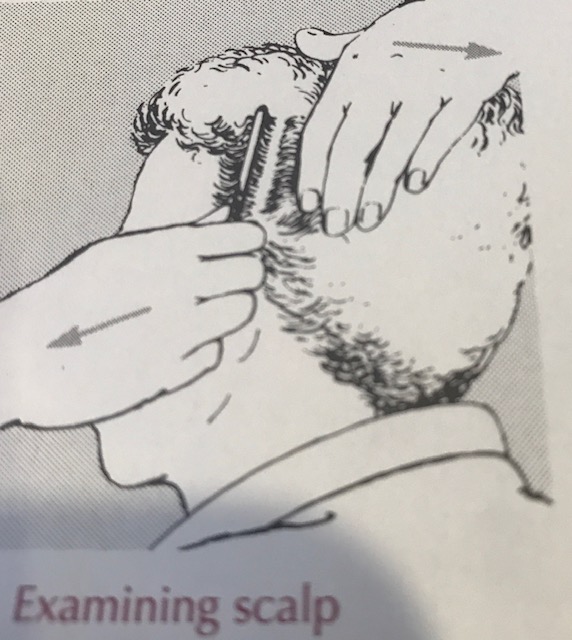
Step 1 Examine Scalp 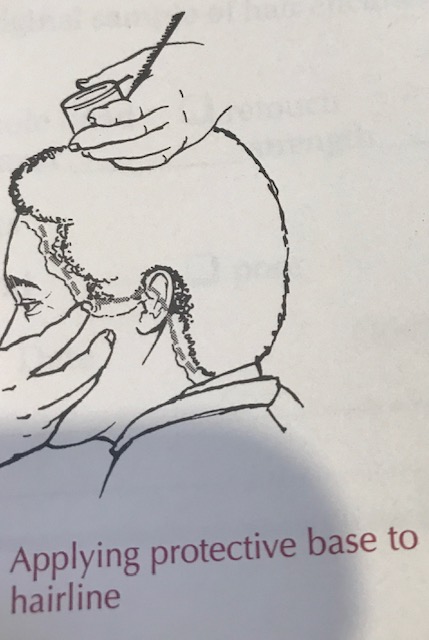
Step 2 Apply protective base to hairline 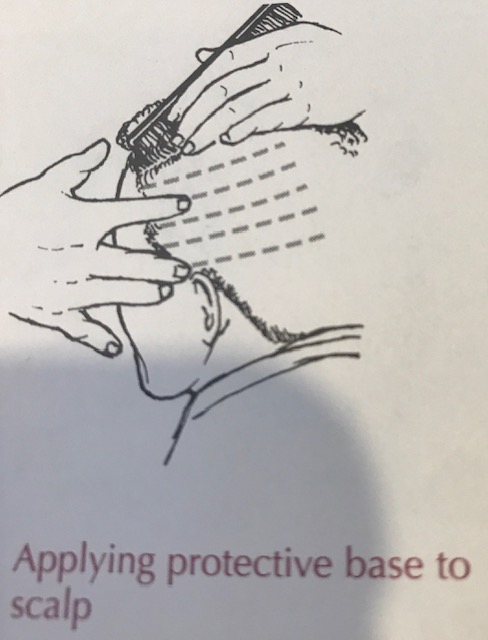
Step 3 Apply protective base to scalp 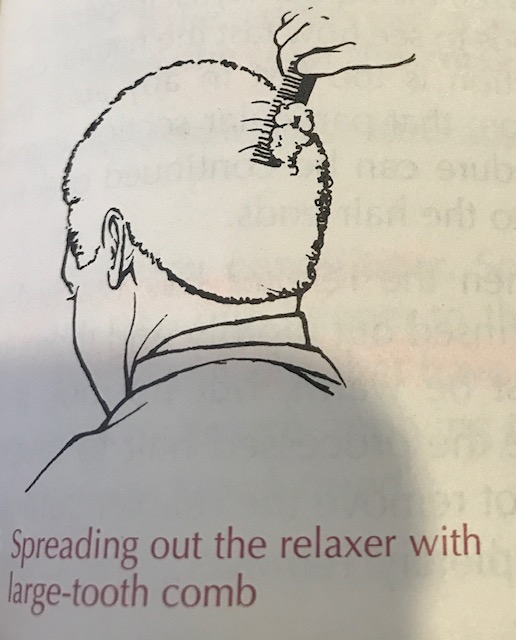
Step 4 Spread out relaxer 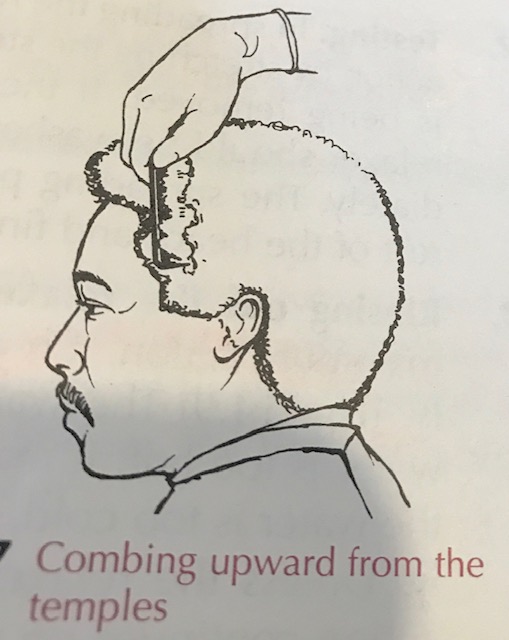
Step 5 Comb upwards from the temples 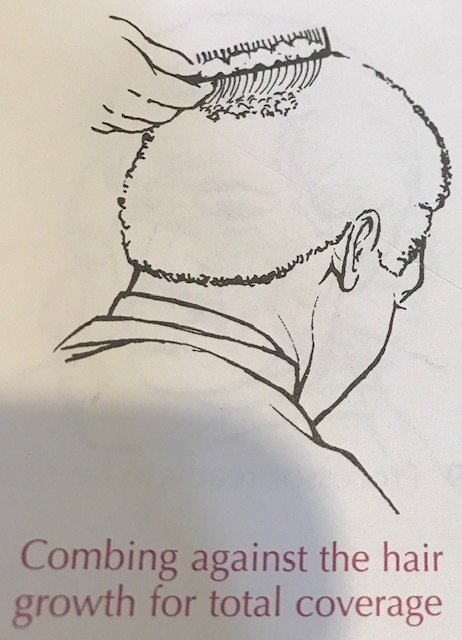
Step 6 Comb against hair growth 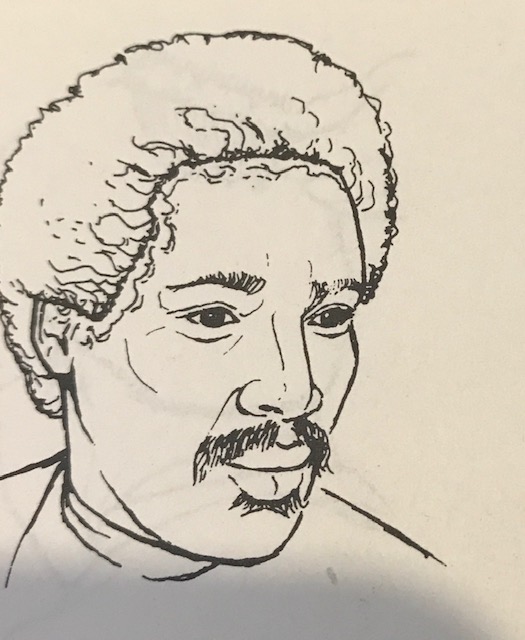
Step 7 Processor ready to be rinsed 
Step 8 Shampooed and combed